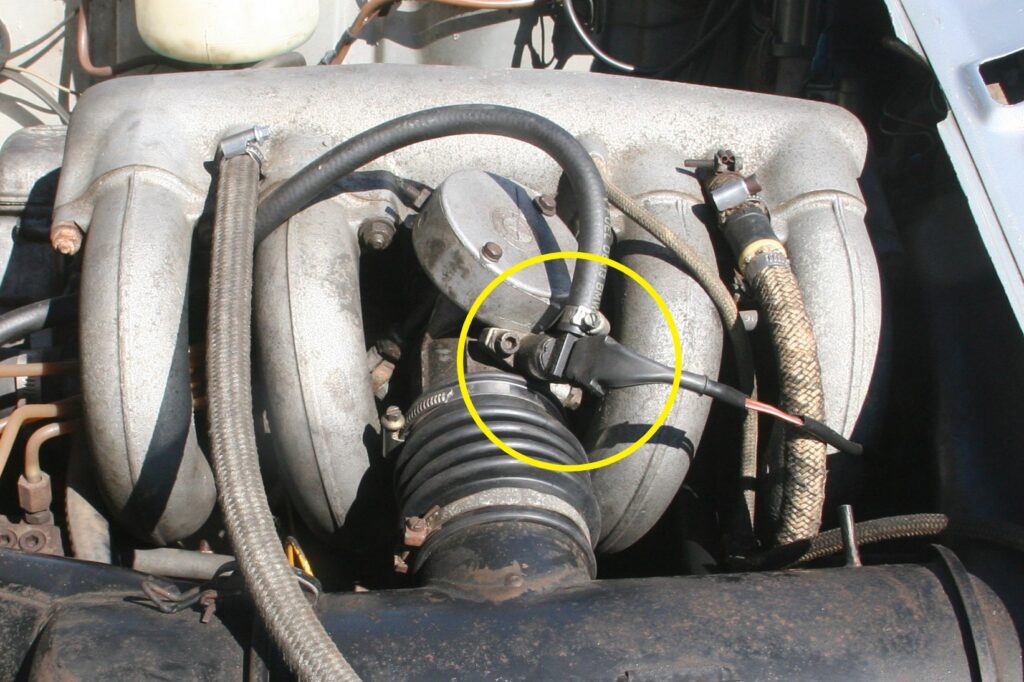Having convinced myself that I’d solved the mysterious brake fluid loss problem in Louie the ’72 2002tii, I began using the car as I believe one should. That is, things like road trips to show a car at a concours or going to cars and coffee gatherings are all fun. But for me, a big part of the joy of owning a cool car is simply running errands in it, as it turns the mundane into an event. Plus, Louie, unlike Hampton (which I did just use for a big road trip to The Vintage and back), has air conditioning, and we were in a hot spell. And the fact that this was the tii that I’d retrofitted a/c into made jumping into it and tooling around in comfort especially sweet.
So I fired up Louie, switched on the cold-blowing Clardy system, and headed out to buy a nice bottle of scotch to take with me when my wife Maire Anne and I went on the mini-vacation in the E9 I wrote about last week. There are certainly liquor stores in Newton where I live, but I opted to take the leafy drive on back roads out to Total Wine in Natick where I could spend 45 minutes losing myself in the endless selection of Islay scotches that taste like dirt marinating in the bottom of a tackle box. Hey, we find relaxation in odd things, and a trip down this kind of rabbit hole, at the end of which will be a selection you know you’ll enjoy because you’re already in the niche of things you know you like, is a real stress-buster for me.
So, with a bottle of value-priced Talisker Storm in hand, I went back out to Louie in the 90-degree heat, and cranked the starter.
To my surprise, the car would not start. There was plenty of juice in the battery, and the starter spun good and fast, but it didn’t even attempt to burble and fire.
Then I remembered: Like the mysterious vanishing brake fluid, this happened a few years back (the car saw virtually no use last year). Unfortunately, it was very hot out, the car wasn’t parked in the shade, and I hadn’t brought my usual road toolbox with me. However, I saw that, under the hood, there was a long jumper wire I’d stashed from the last time this problem occurred. The wire was there to allow me to hot-wire the positive side of the coil directly to the battery. I did, and it made no difference. I flirted with calling AAA (oh the shame! oh the indignity!), but eventually the car started and I beat it back home.
The car-won’t-start decision tree is a pretty well-traveled one. I recently wrote up a detailed one for Hagerty here. And in my recent trip to The Vintage, I encountered both car-cranks-but-won’t-start and car-won’t-crank scenarios, on the same car. The problem with Louie was clearly cranks-but-won’t-start, in which case the cause is almost always either no spark or no fuel. On a tii, there’s the added possibility that the injection belt has snapped, but the fact that the car was running again ruled that out. Doing a basic fuel check on a tii is pretty easy, as you can hear the fuel pump hum as soon as the key is turned, and you can feel the fuel lines vibrating. I did exactly that, and it clearly had fuel.
When a tii has spark and fuel and either cranks but won’t start or starts with extreme difficulty, the problem is usually that the cold-start valve at the top of the throttle body isn’t spraying. The valve has a two-prong connector (hot and ground) that’s triggered by the thermo relay—the silver cigarette-pack-sized box on the left side of the firewall below the wiper motor. The box takes the input from the thermo switch (a bimetallic temperature switch on the water divider attached to the head), and, when the engine is started, fires the cold-start valve for between 1 and 15 seconds depending on temperature. A brilliantly thorough explanation of the function of the relay and bimetallic switch and the pinouts of the connector can be found here on bmw2002faq.com, which remains the hallowed brain trust for the 2002 world. If you pull off the air filter housing and watch the valve while someone cranks the engine, both when cold and when hot, you can see whether it’s spraying, and for how long.

The cold-start valve, and the fuel line and electrical connector that feed it.

The thermo relay box.
If the valve sprays when you hotwire it directly with 12V and ground but isn’t triggered by the relay, pragmatists such as myself have long taken one of two shortcuts that bypass the relay, the bimetallic switch, and wiring. One method is to simply wire in a small pushbutton switch, mount it somewhere convenient and unobtrusive like on the panel under the steering column, and have it feed 12V to the power side of the valve. That way, you have control over whether or not it sprays, and for how long. The other method is to feed the valve 12V from the starter solenoid. That will trigger the valve to spray every single time the key is twisted to the “start” setting to crank the starter, and shut it off when the key is relaxed back to the “run” position. The plus of the second method is that you never need to remember to do anything. The minus is that it sprays fuel when it may not be needed.
I’ve used both of these methods over the years, and I honestly couldn’t remember which, if any, I’d employed on Louie. I couldn’t see any switches or obvious wiring hacks. But a few years back, I had three tiis at the house at the same time, all in various stages of being sorted out, so you’ll forgive me if some details run together in my mind.

No, I don’t remember what I ate this morning, or which tii had which cold start workaround.
If you bypass the thermo relay, you need to supply power to the cold-start valve yourself (the brown wire to the valve’s connector should already be grounded to the chassis), so either you need to splice wires as they go into the valve’s electrical connector (a bit of an, um, hack), or you need to use a connector repurposed from another car, or you need to get power and ground into the connector further upstream on the relay box. A handy way to do it is to look at the pinout of the connector shown in the link to bmw2002faq above and take advantage of the fact that:
- 50 is 12V from ignition during “start”
- 15 is 12V from ignition during both “start” and “run”
- SV is the 12V output to the cold start injector
The other terminals you don’t need when bypassing the relay are:
- 31 is chassis ground
- TK is the ground received from the bimetallic temperature switch
- TH is 12V sent to the bimetallic temperature switch

The pinouts of the thermo relay connector.
So, if you want the cold-start valve to spray while cranking the engine, make a little jumper with two male quick-disconnect connectors (often erroneously called “spade connectors”) on it, and connect it between terminals 50 and SV. If you just want to test the valve, turn the key to “run” setting, and touch the jumper between 15 and SV. You should hear the solenoid in the valve click and see fuel spray out of its nozzle. If you want control over the valve via a switch, you can get power from 15 (or any on-during-crank-and-run fuse or wire), connect it to one leg of a switch, and plug the other leg into SV.
So, how had I set up the cold start in Louie?
Since I’d been starting the car normally without hitting any switches, I assumed that I must’ve wired the cold-start valve to the “start” key position. As per the photo of the thermo relay above, the connector was plugged into the bottom with no jumpers on it, so I wasn’t powering the valve from there. I therefore assumed that I must’ve wired the valve directly to the starter solenoid. When I checked the solenoid, though, I didn’t see additional wires. I did, however, see a thin wire hanging out in space. When I traced it, I found that it was coming through the firewall. When I went inside the car to undo the under-dash panels to identify its source, I was astonished to find the same kind of little red push-button I’ve used to fire the cold start injector on other cars. I had no recollection of putting it there, and had not been using it to start the car.

Didn’t expect THAT.
What’s even weirder is that the switch wasn’t hooked up to anything—there was no source of voltage into the switch, and the output wire was connected to nothing.
So, did I mechanically install this switch in case I needed it, but found that the existing cold start system worked? It’s more likely that I had the panel with the switch left over from some other project. When I bought Louie in 2017 and did the whole Ran When Parked adventure with it, it had an erratic temperature gauge (more than jumpy—it would suddenly peg in the red) that took me quite a while to sort out, so because the instrument cluster had to come in and out many times, I didn’t leave the under-dash panels installed until it was finally fixed. It was at that point that I probably threw on the panel with the switch in it just in case I needed it.
Some of you are likely asking “Was any of this even germane, as the issue wasn’t a cold start but a hot start?” Fair question. It is germane, at least to me, because if you read here, you’ll see that, in 2018, my now-departed tii “Kugel” (the white one in the “tii triplets” photo above) had a similar problem. If you drove it, shut it off, and then tried to restarted it a few minutes later, it’d fire right up, but if you waited more like 20 minutes, you’d have to crank it so much that it’d threaten to drain the battery, It was particularly vexing because I’d wired in a push-button bypass exactly like this, verified by using a remote start switch that it squirted when I cranked, and yet the car was maddeningly difficult to start both cold and hot. It turned out that I’d wired the switch to the accessories setting, which previous unknown to me, is on in the “run” position but cuts off when you turn the key to “start” (go ahead; try it with your radio on) and my clever method of hitting the remote start switch while watching the valve spray did not reproduce the problem.
When a vintage car cranks but won’t start, you always check for fuel and spark. I’d verified that the fuel lines were buzzing, but I had no tools with me, so I couldn’t easily check if the cold-start valve was actually squirting. On the spark end, if you have someone else who can crank the engine while you pull the center wire from the distributor cap and hold it 1/4″ from ground, it’s easy to check, but I didn’t have anyone to help me. When I road trip, I bring a remote start switch so I can do this myself, but I didn’t have it with me. The test that easiest combines fuel and spark is to give the engine a blast of starting fluid down the intake. If the car starts, runs for a few seconds, then dies, that’s the textbook symptom of having spark but not fuel. But I didn’t have starting fluid with me at the time.
The other wired-in diagnostic tool you can take advantage of is simply look at the tachometer. If, when you crank the engine, it bounces rhythmically up off zero, odds are the coil is firing. But if it sits there at the bottom and doesn’t move an iota, then there’s not a signal from the coil being fed to the tach, which, combined with a no-start, likely means there’s no spark. Unfortunately, I’ll freely admit that I forgot to do this.
So, yeah, that’s me being defensive about, right or wrong, zeroing in on the hot-start problem being the cold-start valve. For now, I’ve wired up the little red cold-start switch, verified it works, and will wait to see if I get another hot no-start. And yes, any time I’m using Louie to “turn errand running into an event,” I’ll be certain to bring tools, a remote start switch, and starting fluid. Because, as much as I love these little cars and diagnosing their quirks, sometimes I just want the “event” to be a bottle of Islay scotch, not problem-solving session.
—Rob Siegel
____________________________________
Rob’s newest book, The Best of The Hack Mechanic, is available here on Amazon, as are his seven other books. Signed copies can be ordered directly from Rob here.
Tags: 2002tii red button strarter





















